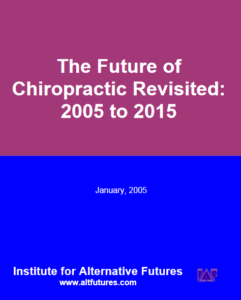Chiropractic group steers members toward full healthcare integration
September 28, 2017
 by John Weeks, Publisher/Editor of The Integrator Blog News and Reports The American Chiropractic Association (ACA) has announced a new brand. More significantly, the dominant national body for chiropractors has set a new, values-based, collaborative and evidence direction for its members. The direction comes with a new statement of its mission and vision. Members must abide by new a Pledge of Professional Values and updated treatment guidelines. The direction comes following significant self-reflection, and admission of past missteps. ACA president David Herd, DC reveals that they “took a hard look at the often unhealthy ways we’ve related to each other and to the larger world of healthcare and we realized it was time to change our way of thinking, working and getting along.” They view the announcement as setting a course for “a healthier direction."
by John Weeks, Publisher/Editor of The Integrator Blog News and Reports The American Chiropractic Association (ACA) has announced a new brand. More significantly, the dominant national body for chiropractors has set a new, values-based, collaborative and evidence direction for its members. The direction comes with a new statement of its mission and vision. Members must abide by new a Pledge of Professional Values and updated treatment guidelines. The direction comes following significant self-reflection, and admission of past missteps. ACA president David Herd, DC reveals that they “took a hard look at the often unhealthy ways we’ve related to each other and to the larger world of healthcare and we realized it was time to change our way of thinking, working and getting along.” They view the announcement as setting a course for “a healthier direction."  In an interview for this article, Herd made clear that the ACA’s declared direction does not pretend to speak for all the nation’s 80,000 licensed chiropractors. The chiropractic profession field has historically been split. ACA is the most significant professional organization with over 11,000 members. Most of the fields researchers and colleges are ACA-affiliated. The ACA, often working in tandem with the Association for Chiropractic Colleges, has driven most of the chiropractors’ national policy advances. A second national organization, the International Chiropractic Association, typically ha perhaps a quarter of the ACA’s current membership. Herd acknowledges that the profession has long been caught in an “internecine war.” When ACA has tried to be a “big tent, you can hold back progress.” Thus, the ACA’s new direction is for those chiropractors who choose to be ACA members. The goal of the branding, for members, was to make the ACA members the public’s “chiropractor of choice.” Embracing a collaborative approach The goal with the public was more sublime. In a slide-deck on the branding, they speak of focusing on “meet(ing) the needs of the public instead of forcing them to fit our beliefs.” The chief values for which the ACA members are now signing on are “Accountability,” ”Consistency,” and “Attitude.” The former focuses on responsibility to patients and public, based on the recently articulated standards. The second announces an alliance with evidence-informed practice. “Attitude” speaks to efforts to overcome the field’s historic and sometime pugnacious isolation. The profession’s planning process, dating back to 2015, had determined that “the profession is very insular, and has an underdog mindset, which is holding it back.” ACA members henceforward pledge to show a “new philosophical attitude toward other health care professionals that moves the organization, and the profession, forward.” Herd shared that the direction promoted here was developed through long internal process. It goes back at least to work percolating since a September 2012 summit in Wisconsin. The long gestation brought consensus. Ultimately, Herd reports, the ACA had very little internal debate and strong alignment. One goal in the re-branding was to re-shape the organization in a way that will be more appealing to younger chiropractors. The ACA’s average member age is presently 57. The message is better aligned with the presently more open era toward chiropractic and other integrative health and medicine practices and practitioners. Herds was pleased to report that the announcement itself had already resulted in over a couple dozen new members. The shift in ideas and orientation came with a new look, new logo, and face on the world. The website for the organization is www.acatoday.org. The cut-line for the campaign underscores the transformative intent: “ACA Today. Not the Same as Yesterday.”
In an interview for this article, Herd made clear that the ACA’s declared direction does not pretend to speak for all the nation’s 80,000 licensed chiropractors. The chiropractic profession field has historically been split. ACA is the most significant professional organization with over 11,000 members. Most of the fields researchers and colleges are ACA-affiliated. The ACA, often working in tandem with the Association for Chiropractic Colleges, has driven most of the chiropractors’ national policy advances. A second national organization, the International Chiropractic Association, typically ha perhaps a quarter of the ACA’s current membership. Herd acknowledges that the profession has long been caught in an “internecine war.” When ACA has tried to be a “big tent, you can hold back progress.” Thus, the ACA’s new direction is for those chiropractors who choose to be ACA members. The goal of the branding, for members, was to make the ACA members the public’s “chiropractor of choice.” Embracing a collaborative approach The goal with the public was more sublime. In a slide-deck on the branding, they speak of focusing on “meet(ing) the needs of the public instead of forcing them to fit our beliefs.” The chief values for which the ACA members are now signing on are “Accountability,” ”Consistency,” and “Attitude.” The former focuses on responsibility to patients and public, based on the recently articulated standards. The second announces an alliance with evidence-informed practice. “Attitude” speaks to efforts to overcome the field’s historic and sometime pugnacious isolation. The profession’s planning process, dating back to 2015, had determined that “the profession is very insular, and has an underdog mindset, which is holding it back.” ACA members henceforward pledge to show a “new philosophical attitude toward other health care professionals that moves the organization, and the profession, forward.” Herd shared that the direction promoted here was developed through long internal process. It goes back at least to work percolating since a September 2012 summit in Wisconsin. The long gestation brought consensus. Ultimately, Herd reports, the ACA had very little internal debate and strong alignment. One goal in the re-branding was to re-shape the organization in a way that will be more appealing to younger chiropractors. The ACA’s average member age is presently 57. The message is better aligned with the presently more open era toward chiropractic and other integrative health and medicine practices and practitioners. Herds was pleased to report that the announcement itself had already resulted in over a couple dozen new members. The shift in ideas and orientation came with a new look, new logo, and face on the world. The website for the organization is www.acatoday.org. The cut-line for the campaign underscores the transformative intent: “ACA Today. Not the Same as Yesterday.”  Comment: As I listened to Herd describe ACA’s new direction, I thought of the Welsh poet and author Dylan Thomas in Adventures in the Skin Trade. The author as first-person narrator – I paraphrase - speaks of the times in life when one turns around and discovers, suddenly, that one has shed a skin. This is such a time for the ACA chiropractors. In the past, the feisty chiropractors have typically had mission statements that were, essentially, about chiropractic. The new mission doesn’t even mention the profession: “To inspire and empower our members to elevate the health and wellness of their communities.” Herd anticipates the change in the profession will take time: “We hope it will become a magnet for a meaningful approach.” A “preferred scenario”
Comment: As I listened to Herd describe ACA’s new direction, I thought of the Welsh poet and author Dylan Thomas in Adventures in the Skin Trade. The author as first-person narrator – I paraphrase - speaks of the times in life when one turns around and discovers, suddenly, that one has shed a skin. This is such a time for the ACA chiropractors. In the past, the feisty chiropractors have typically had mission statements that were, essentially, about chiropractic. The new mission doesn’t even mention the profession: “To inspire and empower our members to elevate the health and wellness of their communities.” Herd anticipates the change in the profession will take time: “We hope it will become a magnet for a meaningful approach.” A “preferred scenario”  The ACA’s decision to follow values such as evidence, standards, collaboration and accountability follows a series of related actions for the field. The ACA, for instance, recently took the remarkable step of joining the Choosing Wisely campaign – through which it is working to diminish over-utilized services. This is the action of a maturing guild. In addition, a subset of chiropractic leaders, including Herd’s predecessor as a ACA president Tony Hamm, DC and a longtime policy and research leader Christine Goertz, DC, PhD, are working on standards and accountability from a different direction, via the organizing the Spine Institute for Quality, for which I am providing some support. Notably, each of these may be viewed as setting up future chiropractic doctors for what futurist Clement Bezold, PhD determined was the field’s “preferred future” in his 2013 publication, The Future of Chiropractic Revisited. This is Scenario 3: Integration and Spine Health Leadership. In this possible future, “chiropractic enters mainstream medicine as the spinal health expert in the health care system. Many join [Patient Centered Medical Homes] and other integrated care teams and become critical partners in addressing back pain and spinal health.” Bezold’s “Revisited” version of his futures work for chiropractic also included a remarkable break with his past efforts. Instead of framing chiropractic’s future around unity, he suggested that the field was likely to remain split. The ACA’s new face, brand, and intention are clearly on track with both Scenario 3 and this realistic perspective. Editor’s note: This analysis article is not edited and the authors are solely responsible for the content. The views and opinions expressed in this article are those of the authors and do not necessarily reflect the official policy or position of Integrative Practitioner.
The ACA’s decision to follow values such as evidence, standards, collaboration and accountability follows a series of related actions for the field. The ACA, for instance, recently took the remarkable step of joining the Choosing Wisely campaign – through which it is working to diminish over-utilized services. This is the action of a maturing guild. In addition, a subset of chiropractic leaders, including Herd’s predecessor as a ACA president Tony Hamm, DC and a longtime policy and research leader Christine Goertz, DC, PhD, are working on standards and accountability from a different direction, via the organizing the Spine Institute for Quality, for which I am providing some support. Notably, each of these may be viewed as setting up future chiropractic doctors for what futurist Clement Bezold, PhD determined was the field’s “preferred future” in his 2013 publication, The Future of Chiropractic Revisited. This is Scenario 3: Integration and Spine Health Leadership. In this possible future, “chiropractic enters mainstream medicine as the spinal health expert in the health care system. Many join [Patient Centered Medical Homes] and other integrated care teams and become critical partners in addressing back pain and spinal health.” Bezold’s “Revisited” version of his futures work for chiropractic also included a remarkable break with his past efforts. Instead of framing chiropractic’s future around unity, he suggested that the field was likely to remain split. The ACA’s new face, brand, and intention are clearly on track with both Scenario 3 and this realistic perspective. Editor’s note: This analysis article is not edited and the authors are solely responsible for the content. The views and opinions expressed in this article are those of the authors and do not necessarily reflect the official policy or position of Integrative Practitioner.



















SHARE